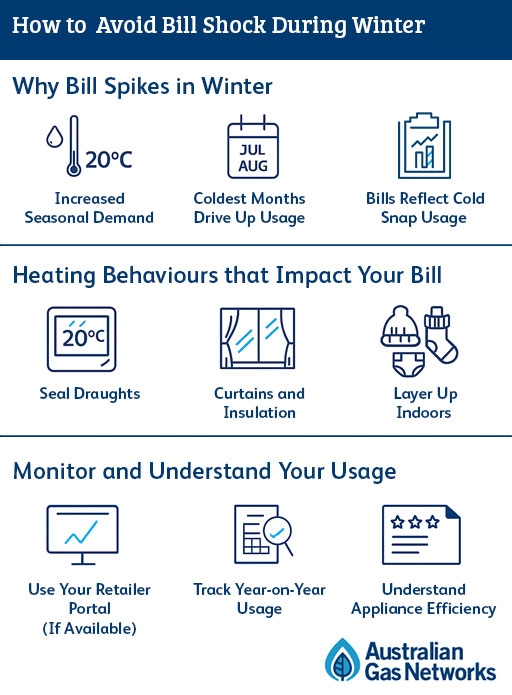As temperatures drop across Australia, energy bills tend to rise – a seasonal pattern that often catches households off guard. Whether you use gas or electricity to heat your home, winter is the time when usage typically peaks. This sudden rise in energy costs can result in what's commonly referred to as "bill shock".
Key Summary
- Set Smart Temps: Keep thermostats at 18–20 °C and heat only the rooms you use.
- Track Your Usage: Check retailer portals or Energy Made Easy to spot spikes early.
- Know the Peaks: Expect higher gas use June - August, especially during cold snaps.
- Check Rates: Retail prices can shift in winter, review your energy bill and stay informed.
While this guide focuses primarily on gas use, many of the behaviours and solutions discussed, such as thermostat management, zoning, and draught-proofing, are effective across both gas and electric heating systems. These strategies help improve energy efficiency regardless of the energy type.
Advice specific to gas includes tips on using gas heaters and hot water systems efficiently, as well as understanding how billing cycles and seasonal demand can impact gas consumption. Our aim is to help you understand why winter energy costs spike and to provide practical, comfortable ways to manage your winter heating expenses.
As always, Australian Gas Networks (AGN) is here to support your energy literacy. We deliver gas to homes and businesses across Australia but do not set retail prices or issue customer bills.
Why Gas Bills Spike in Winter
1. Increased Seasonal Demand
In colder months, gas usage rises significantly due to heating and hot water needs. According to the Australian Energy Regulator, residential gas consumption increases in colder months due to higher heating and hot water demand.
2. Billing Period Overlaps
Winter gas bills may include more high-use days depending on your billing cycle. A bill covering mid-June to mid-August, for example, will likely be higher than a bill covering mid-April to mid-June. It's important to consider this when comparing bills.
Note: Gas prices are set by retailers and vary by region and provider.
When to Expect Winter Spikes
Winter spikes in gas usage typically occur from June to August, with the sharpest increases during cold snaps. The Bureau of Meteorology (BOM) regularly issues climate outlooks, helping households anticipate cold periods. Reviewing your previous year's bills for these months can provide a baseline for what's to come.

Heating Behaviours That Impact Your Bill
Thermostat Settings
During winter, set your thermostat to 18-20°C in living areas. This recommendation applies to both gas and electric heating systems. Maintaining moderate thermostat settings can significantly reduce energy use, regardless of the type of heating you have. Higher thermostat settings can lead to greater energy use, according to Energy.gov.au.
Room Zoning
Only heat rooms that are in use and keep doors closed to trap warmth. This is particularly effective in larger or open-plan homes.

Small Actions That Add Up
Seal Draughts
Gaps around windows and doors can lead to significant heat loss. Draught stoppers, weather stripping, and even a rolled-up towel can help maintain room temperature more effectively.
Curtains and Insulation
Thick curtains and proper roof insulation help reduce heat escape. According to Sustainability Victoria, uncovered windows can contribute significantly to heat loss if not properly insulated.
Dress for the Season
Wearing layered clothing and warm socks indoors can reduce the temptation to turn up the heat. It’s simple and completely free.

Monitor and Understand Your Usage
Use Retailer Portals
Many providers do offer tracking or apps - Finder.com.au (mainly electricity, but some gas) that allow you to monitor your gas usage in near real-time. Checking your usage midway through the billing cycle can help you make adjustments before costs climb.
Compare Year-on-Year Usage
Review your energy usage over the same period from the previous year. A noticeable increase could indicate changes in your household habits, such as working from home more often, hosting guests, or adding new appliances.
To manage rising costs, it’s wise to compare deals from different energy retailers regularly to ensure you’re on the most competitive tariff. Additionally, keeping your appliances well-maintained can significantly improve their efficiency, helping to reduce overall energy consumption.
Understand Appliance Efficiency
Tools like the Energy Rating Label and Energy Made Easy allow you to assess the energy efficiency of existing appliances. If you're already considering replacing an old heater or hot water system, check these tools to make informed choices. We don’t promote upgrades – this advice is purely informational.
Pair with Other Savings Tips
You can layer these strategies with other cost-saving habits covered in AGN’s helpful guides:
- 10 Ways to Reduce Your Gas Bill Without Sacrificing Comfort
- Understanding Your Gas Bill: A Complete Guide
Here are a few quick add-ons to reinforce energy-efficient habits:
- Shorten showers to 4 minutes to reduce hot water usage (sustainability.vic)
- Use timers or programmable thermostats to prevent unnecessary heating
- Compare energy providers to ensure you are getting the best deal
- Turn off heating 15 minutes before going to bed or leaving home (energy.gov)
These small habits can collectively lower your gas usage over time, depending on your home and appliance efficiency.
Understand Retailer Pricing
While Australian Gas Networks delivers gas to your property, your retailer is responsible for setting the rates you pay for gas. Retailers may increase their pricing in winter due to higher wholesale costs, increased demand or scheduled annual contract changes.
These adjustments can significantly affect your bill. If you notice higher rates or unexpected charges, it may be a good time to compare offers from other providers. The federal government's Energy Made Easy tool allows you to compare gas and electricity plans using your actual usage data.
By understanding your plan details, such as tariffs, discounts and contract terms, you can make more informed decisions and potentially reduce your energy costs this winter.
Conclusion
Winter gas spikes are a reality for many Australian households, but they don’t have to lead to financial stress by:
- Understanding why and when bills spike
- Adapting your heating behaviours
- Making small but effective changes around the home
- Using the tools available through your retailer and government sites
You can stay ahead of “bill shock” while keeping your home warm and welcoming. Be proactive this winter. Review your thermostat, check your usage, and consider where you can adjust habits while maintaining a pleasant indoor climate.
- Australian Energy Regulator (2024). Seasonal Trends in Residential Energy Use
- Energy.gov.au. Household Heating Guide
- Bureau of Meteorology. Seasonal Climate Outlooks
- Energy Made Easy. Compare and Understand Energy Use
- Sustainability Victoria. Heat Your Home Efficiently
- Finder. Energy Provider Apps
All information provided in this article was correct at the time of publishing (August 2025)


